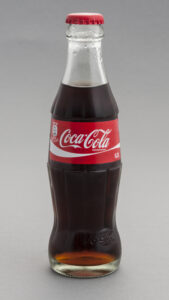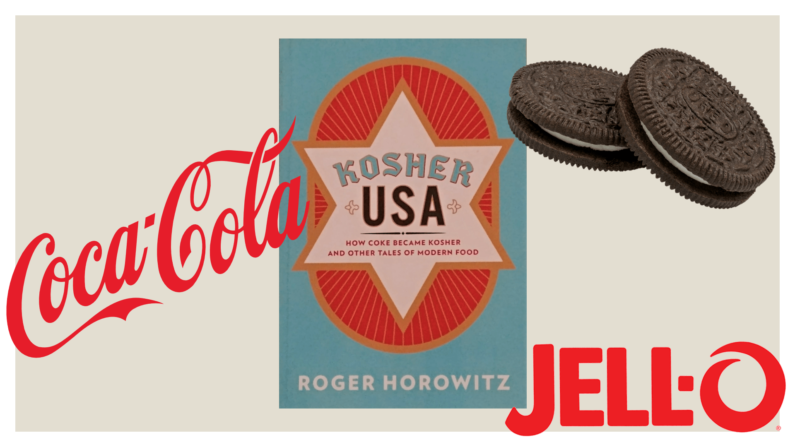I’ve written a bit previously about American Jewish Food, a particularly rich and varied topic. Examples of such posts include my exploration of Jewish-American deli and the review that included books on bagels and knishes. But those posts have only barely scratched the surface, and there will be many more to come.
But for now I want to focus on one of the many excellent books on the subject, as my next post from The Jewish Food Bookshelf. Today’s selection is a relatively newer selection, first published in 2016. Kosher USA: How Coke Became Kosher and Other Tales of Modern Food, by Roger Horowitz, is a fun and highly readable study that accurately matches its title.
American Jewish Food History
As the story of American Jewry is one of the greatest in modern Jewish history, the story of Jewish food in America is equally as fascinating. Horowitz’ book focuses on a few of the longest-lasting features of that tale. As I mentioned in my article about hot dogs, the rapid and full integration of Jews into American society has been reflected very much in the cuisine of Jewish America. Along with this, came the explosion of the kosher certification business. Both of these topics feature prominently in Horowitz’ book, as I’ll detail below.
Beyond that, Kosher USA digs deeper to explore the complications to kashrut that stem from the industrial food industry. New ingredients and the difficult balancing act between humane practices and the need to compete are two of the issues the book looks at. Horowitz uses prominent examples for each topic, supplementing them with personal anecdotes and an accurate portrayal of the complexities of Jewish law when it comes to what foods we put in our bodies. The stories he uses are both illustrative and entertaining, and at times surprising.
What’s Inside?

Two chapters look at the challenges posed by modern scientific industrialization of the food production process, and the questions that development raised for kosher consumers. Coca-Cola had an issue on Passover due to grain alcohol being used during the manufacturing process, despite no alcohol remaining in the final process. Additionally, glycerin was included, and was derived from sources that made it questionable as a kosher product. Similarly, the gelatin in Jell-o presented potential challenges to kosher rules. Both of these cases not only raised questions for kosher consumers, but drove wedges between segments of the American Jewish community when contrary opinions came from rabbis in different denominations.
Some of these debates led to the expansion of the kosher certification industry, led at first by the OU, and later growing to include three other majors as well as hundreds of smaller supervision agencies. These, too, exacerbated tensions between different groups of Jews, while simultaneously increasing the quantity of kosher food options available.
Further assisting the growth of the supervision agencies was a perception among the general (non-Jewish) populace that kosher certification equaled an assurance of quality. As an example of this, Horowitz looks at the 1990s certification of Oreo cookies as kosher. (I also posted a link to a recent article about this concept in my latest newsletter.)
One of the other complications of industrial food production that Horowitz highlights relates to commercialization. Many companies closely guard their recipes, and might even not reveal all of the specific ingredients they use. This of course challenges the ability of rabbis to certify the products as kosher, and thus workarounds needed to be created in many cases.
The final two chapters of the book focus on the topic that pushed Horowitz to write the book in the first place: kosher meat. He looks, in depth, at the development of the slaughtering industry from a time when huge percentages of the meat industry in New York (even for non-kosher butchers) was done by kosher shochetim (slaughterers), to a time when factory farming, slaughter, and processing have raised numerous ethical questions. Along the way, technology, changing trends in religious demographics, the growing power of supervision industries, and increased financial competition all affected the industry. The questions and challenges facing that industry remain today, as an open question at the end of this book.
Overall, Kosher USA does a great job of summarizing a wide array of broad topics and themes. Anyone interested in the changes that have taken place to kosher food in America over the past century-plus will find a wealth of solid information here. I should say that there is a second book (which I have not yet read) on what appears to be a similar topic: Sue Fishkoff’s Kosher Nation: Why More and More of America’s Food Answers to a Higher Authority. Additionally, many other books and articles look at more narrow but specific topics in American Jewish cuisine. Some of the scholars whose work on the topic I recommend include Hasia Diner, Eve Jochnowitz and Jenna Weissman Joselit.






